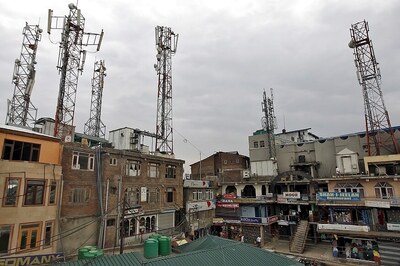
views
In the National Capital Territory (NCT) of Delhi, Chief Minister Arvind Kejriwal has been at loggerheads with Lieutenant Governor (LG) V.K. Saxena since the latter took charge in May 2022. “Who is LG, and where did he come from?” asked the Delhi CM recently. The plausible answer could be from Articles 239 and 239 AA of the Constitution of India dealing with Union Territories in general and the NCT of Delhi in particular. Similarly, Punjab Chief Minister Bhagwant Mann, referring to Governor Banwarilal Purohit, said he was answerable only to three crore Punjabis and not to a Centre-appointed governor. Was he questioning the person or the institution? The Punjab government, neck-deep in debt, had sent 36 school principals to Singapore for professional training. Raj Bhawan had apparently received complaints of malpractice in the selection of those principals. Purohit inquired about the criteria of the Punjab government for selecting the principals. Mann shot back a strongly worded reply in Punjabi. He wanted to know the basis for the appointment of governors in absence of criteria laid down by the Constitution.
The Constitution, to be honest, lays down no educational or professional qualification for the post of governor. The same, however, is equally true for the president and vice president of India, prime minister, speaker of Lok Sabha, union ministers, chief ministers or ministers of the states. There are only age-related qualifications for legislators, the president and the vice president etc. Is Mann striking a pose merely to avoid replying on the issue or is he raising a valid Constitutional question? In the former case, any citizen of India under the RTI Act, 2005 or any legislative assembly member (vide Punjab Vidhan Sabha Handbook, 2002, P.17) still has the right to seek the answer from the Punjab government on the floor of the House.
A stormy relationship between the governor and chief minister of a state is not unusual. In recent times, Jagdeep Dhankar and Bhagat Singh Koshyari, the then Governors of West Bengal and Maharashtra had the experience of being in the line of fire from the respective state governments. The pretext of attack could be anything, ranging from observations about the deteriorating law and order situation in West Bengal to saying that Samarth Ramdas was the mentor of Chhatrapati Shivaji. Tamil Nadu Chief Minister M K Stalin recently had a face-off with Governor N. Ravi. In a history of sorts, the governor walked out of the Tamil Nadu Legislative Assembly, after the ruling party pushed a resolution to expunge parts of his address, where he departed from the customary text prepared by the Cabinet. The discordant situation results from the political malaise between the Centre and the states when they are ruled by opposing parties.
The governor of a state occupies a rather curious position under the Constitution. He stands at the intersection of democracy and the federal structure of the republic. Under Article 154, the executive power of the state is vested in the governor, who shall exercise it directly or through the officers subordinate to him, in accordance with the Constitution. It reads like a provincial version of Article 53, wherein the executive power of the Union is vested in the president of India, who shall exercise it directly or through officers subordinate to him, in accordance with the Constitution. In both cases, an occupant is obliged to act on the aid and advice of the Council of Ministers. In both cases, no court can inquire whether any or what advice was given by the Council of Ministers. The governor (vide Article 168) is a constituent part of the state legislature, whether unicameral or bicameral, like the president (vide Article 79) is a constituent part of the Parliament of the Union. T. Hanumanthappa, in his eminently readable essay Law Making Power of the Governor: Ordinances, cites the important difference in the legislative powers of the president enumerated in Articles 123 and 213 respectively. The governor cannot promulgate an ordinance without instructions from the president in the circumstances mentioned in sub-clauses (a) to (c) of Article 213 (1) (Journal of Parliamentary Information, July, 1977, P.401).
However, similarities between the two august offices cease here. While the president of the Republic is elected according to the provisions of the Constitution (Articles 54 & 55), the governor is nominated by the president. The governor holds the office at the pleasure of the president, though the term can extend to five years (Article 156). The Constitution allows the same person to be appointed as governor of two or more states at the same time (Article 153). However, the president himself is bound by the aid and advice of the Union Council of Ministers, in all his decisions. The appointment of the governor is no exception to the rule. This effectively makes the governor a nominee of the Union government. This is evident by the fact that many governors have been former Union ministers, chief ministers or legislators elected on the ticket of the party ruling at the Centre. At least they have been primary members of the ruling party or coalition. Apolitical governors like former civil servants, retired military generals and social activists are not unknown either. They, however, have to be inclined to the ideology of ruling dispensation at the Centre.
The present-day political partisanship jeopardises chief minister’s deference towards the governor. A governor could be perceived as an “agent” of the Centre to control the state government. However, a governor was not taken quite kindly by chief ministers even when there existed a great deal of political homogeneity. He, after all, was a nominated person, from a different state without any political base. Vishnu Sahay, ICS, who later became Governor of Assam, cites his interaction with Dr. Govind Ballabh Pant, the then Chief Minister of Uttar Pradesh in 1951. The Governor then was Homi Mody, a distinguished industrialist from Bombay “with a reputation for ability and patriotism without political influence.” Dr. Pant, then, at his peak of political influence, announced the appointment of a minister even without informing the governor, whose prerogative it was to appoint ministers. It was evidently an act of oversight, rather than deliberate mischief. However, Dr. Pant’s curt reply was that the “Governor may, if he likes, send down a note, but he should not afterwards enquire about it” (Governor’s Role in Administration, Ed. Abhijit Datta, Union-State Relations, P.68).
As Vishu Sahay informs, in early days of independence, people’s ideas about role and function of governor were still unclear. It took them time to realise that “notwithstanding his inheritance of Government House, complete with a Guard of Honour and red-tabbed ADC, the Rajyapal was obviously not a continuation of the departed Lat Sahib.” He could not act as the court of appeal against the action of popular ministry.
Though the Constitution has put his role, power and function, on legal basis, people still regard the governor as an ombudsman, a “guardian of the state.” In the aftermath of the All India Trinamool Congress’ victory in assembly elections (May 2, 2021), heavy political violence had broken out in West Bengal. The then West Bengal Governor Jagdeep Dhankar visited some trouble-torn areas of the state, and adjoining areas of Assam, where camps had been set up for the fleeing Bharatiya Janata Party (BJP) supporters. A section of people actually believed that the governor would soon invoke Article 356 of the Constitution of India to recommend the imposition of President’s rule on the ground that Constitutional machinery had failed in the state completely. As late as March 7, 2022, a delegation comprising 54 BJP MLAs met the governor to demand imposition of the President’s Rule, arguing that the law and order has collapsed in the state. The governor, of course, did no such thing, aware of his legal limitations. Mamata Banerjee’s government had been sworn in with a huge majority, only a few months earlier. Any such recommendation on his part was sure to be challenged in the court of law. While the court could be receptive to the idea of remedy in individual cases of political violence, as matter of violation of human rights, the act of dismissal of a popular government was sure to be struck down.
An indiscriminate use of Article 356 (1) was the hallmark of Indira Gandhi’s era. The report of Justice Sarkaria Commission on Centre-State Relations (1988) observes that in the initial days of the Republic, this provision was invoked sparingly. Up to the end of 1967, it had been used only 12 times. However, over the ensuing 18 years, it was used on 62 occasions. (Report of Commission on Centre-State Relations, Part-I, P.165). This brand of Indira Gandhi’s politics undermined the credibility of governor’s office.
Eminent Jurist (and former Attorney General of India), Late Soli Sorabjee, pertinently observed- “It will not be exaggeration to say that no institution or constitutional office has suffered greater erosion or degradation than the office of Governor. The public, today, generally regard the Governor as an employee of the Central Government and in some cases, spy of the Centre. The unfortunate fact is that few incumbents of this high office have any clear conception of their role in our constitutional scheme and, in fact, regard themselves as the lackeys or employees of the Central government and readily act according to its behest.” (Quoted in Justice M.M. Punchhi Report of Commission on Centre-State Relations Vol-1, P.72)
S.R. Bommai v/s Union of India (AIR 1994, S.C. 1918) was a landmark judgment, wherein the Supreme Court held that the proclamation under Article 356 (1) is not immune from judicial review. The post-Bommai is a different era in terms of Centre-state relationship. However, this cannot alter the reality that the political space of India remains fragmented. The governor, a nominated person, could still ruffle the feathers of the chief minister, an elected person, even by conscientiously discharging his duty. Most chief ministers, as Vishnu Sahay tells, “tended to be impatient if a governor read the Constitution too literally.” Governors are likely to be seen as instruments of politics even if they act as instruments of vigilance.
The writer is author of the book “The Microphone Men: How Orators Created a Modern India” (2019) and an independent researcher based in New Delhi. The views expressed herein are his personal.
Read all the Latest Opinions here

















Comments
0 comment